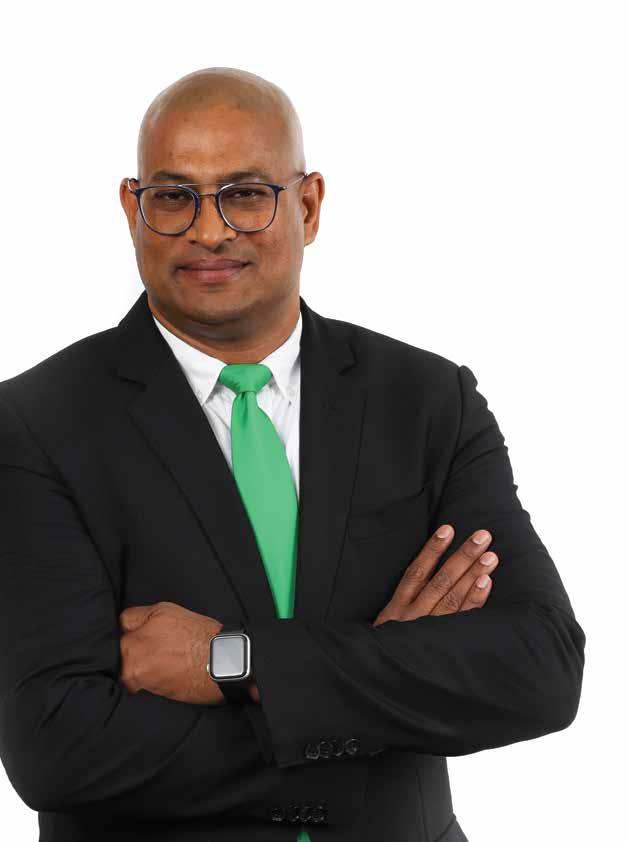
4 minute read
The Green Economy – Our Place in History Starts Today
By Devan Pillay, Cluster President: Anglophone Africa at Schneider Electric
In a time when the planet is under tremendous pressure, facing the existential threat of complete environmental degradation, it’s clear that company profits and strategies cannot exist in isolation. t his dialogue becomes even more imperative when considering how sustainability initiatives impact the organisational bottom line.
Driving the move towards sustainability is the consumer. A growing consciousness is perpetuated by realities such as power and water shortages and how one can contribute to the circular economy.
Consumers are readily adapting and becoming more mindful of when and how they consume the planet’s valuable resources. this shift in consumer behaviour also sets the tone for companies and their sustainability endeavours.
Sustainability is not an ‘either-or’ scenario. it should be integrated within the very foundation of organisational processes and operations. when businesses examine their organisational processes, they must do so with sustainable practices in mind.
Furthermore, embracing sustainability is not just an environmental concern. it encompasses various socioeconomic elements like skills development, diversity and corporate governance. And again, corporate governance is more than just an optional add-on. it forms a critical part of a company’s identity and brand.
Realising the greener economy
It’s also important to consider the scalability of sustainability initiatives. Many companies start with small kilowatt inverters, which offer room for expansion and growth. this is precisely what we advocate. Lay the foundation and build on it.
The goal is to avoid a situation where you’re forced to make a sudden, disruptive change. instead, make progressive investments from the outset. This approach will benefit both the market and the customers you serve.
The good news is there’s a growing demand for circular economy practices. For instance, at Schneider Electric, we produce circuit breakers, large, bulky items made of plastic and metal. we’ve had to step back and rethink our product design to enable reusability and component harvesting at the end of life. this commitment drives our R&D efforts throughout our various offerings, which result in more sustainable product design and manufacturing.
Transitioning to a greener economy, mainly through adopting renewable energy sources, comes with its own challenges. the cost of renewables like green hydrogen, wind and solar can be prohibitive.
That said, collaboration amongst organisations drives innovation, and green initiatives are becoming more viable. Again, Schneider Electric and many of our peers invest heavily in R&D to find cost-effective solutions bolstering the green economy.
Electricity 4.0
As an organisation, one of our core differentiators is the ability to integrate components seamlessly through our myriad of digital solutions, thereby providing a holistic approach to sustainability. Our digital solutions collect and provide essential information that assists organisations in making informed decisions that will aid their sustainability endeavours.
Another vital part of this journey is electrification. Whilst the traditional image of electricity generation is generally associated with polluting power plants, we focus on harnessing renewable energy from green energy sources. Our emphasis lies in utilising this energy effectively and efficiently to stimulate economic growth and ensure accessibility for everyone.
We aptly refer to this approach, which closely aligns with industry 4.0, as Electricity 4.0. Together with our partners worldwide, we are building a new Electric world that provides smart energy to homes, buildings, data centres, industries, infrastructure, and grids.
Electricity is the most efficient energy. It is also the best vector for decarbonisation. By 2040, the share of electricity in everything we do will double, reaching at least 40% of final energy consumption. Six times more electricity will be generated from solar and wind.
It should also be noted that electrification and digitisation must go hand in hand, as one complements the other. without both, navigating the challenges of industry 4.0 will become increasingly challenging.
An evolving workforce
Undoubtedly, education and training must adapt to meet the demands of a workforce that focuses on green initiatives. Online learning and apprenticeship programmes are stepping to the fore, providing essential platforms for individuals to gain the necessary skills in this changing, greener economy.
At tertiary institutions, we are seeing a blending of disciplines. Mechanical engineers now work with electronics, and new curriculum pathways like Mechatronics bridge these fields, representing the integration of modern technology with traditional learning.
We also need to rethink how learning is structured, breaking it down into smaller, more flexible segments moving away from the traditional one-size-fits-all approach. The evolving workforce and industry landscape present challenges, but it offers opportunities for growth and adaptability.
Ultimately, moving towards an economy driven by sustainable practices requires a full-time commitment by organisations and individuals. Our planet’s resources are finite. However, we can solidify our place in history through collaboration, innovation and commitment.










